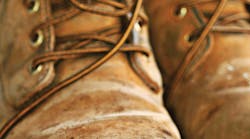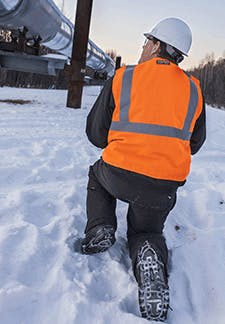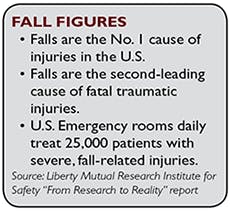Thousands of workers trudge into the arctic climate, assaulted by subzero temperatures.
Winds whip across the tundra, a -53-degree-affront to those brave enough to endure the harsh environment.
Alaska's North Slope -- where BP operates the Prudhoe Bay Oil Field – is 250 miles north of the Arctic Circle, a place where plumbing often freezes and discussions about super-insulated homes are routine, a place where darkness lasts for months on end.
It's a place where oil workers converge to extract oil from wells and deliver it to the Trans-Alaska pipeline.
It's a dangerous place for risky work.These conditions – that unparalleled environment – are what created a new market for traction products.
Implus – the North Carolina-based footwear manufacturer – outfits BP's workers on the North Slope each year with its ICEtrekkers Diamond Grip product, an over-shoe product that features steel alloy beads strung on steel aircraft cables and riveted to a rubber sling.
"These are considered part of the required PPE for North Slope work," says Dawn Patience, BP press officer for Alaska. "This requirement matches the environment we work in."
The company requires employees to use footwear traction devices when walking or working outdoors in icy or snow-covered conditions. Those devices, however, are removed while workers are indoors. The intent, Patience says, is to "achieve a practical workable solution for traction devices."
And that's the point – finding a safe, workable footwear solution.
"You have guys wearing heavy, heavy equipment, trying to maintain their balance and not get hurt on the job," says Michael Maher, a PR representative for Implus.
As Eric Lund, Implus manager of marketing for outdoor brands, explains, the goal is to create "as natural of a feeling as possible" with traction devices.
Therein lies the crux of footwear products – especially those designed for slip and fall protection: to create unobtrusive, comfortable footwear that gives workers their best chance at safety.
A Step in the Right Direction
The trick is in figuring out how to design that perfect product.
"I could sit in my cube and think up what I think is the best product in the world," says Robin Skillings, Honeywell senior product marketing manager of safety footwear for the Americas.
But that doesn't mean there would be a need for it, nor does it mean the market would accept it.
Instead, Skillings largely relies on her sales force to get her on site with customers to see how footwear is being used.
"The whole key element is getting out and talking with customers," Skillings says.
On site visits, she takes note of everything – from the type of job being done to what type of surface workers are standing on – all in an effort to see the "whole body mechanics" of the employee and to assess the situation.
"Watching somebody wearing their footwear, you get a lot of key insights about how they move and what their work consists of," Skillings says.
Sometimes the focus is on ergonomics: how to help a worker in a factory with cement floors stand all day without discomfort. Other times, it's on safety: adding a heel to the boot of a construction worker to prevent slips on ladders.
The end goal, however, is the same: to help reduce the number of foot-related injuries in the workplace.Each year, there are about 52,600 foot-related injuries a year, which result in an employee missing a median of nine days of work, according to the Bureau of Labor Statistics. And one slip and fall can cost a company $30,000 to $50,000 in claims, Lund says.
That's why companies like Boeing are providing employees with foot protection just to navigate potentially icy parking lots on their walk from the car into the facility.
And footwear manufacturers like Honeywell are introducing a new line designed for women – an ever-growing segment of the industrial workforce. The footwear, which will debut this spring, is designed around the shape of a woman's foot, therefore creating a lower risk of falls or for discomfort.
"A lot of the footwear you see for women are built on a man's foot, so they are large and wide and heavy and clunky," Skillings says. "It's a very underserved market."
Where the Rubber Meets the Road
Many workers – especially those in fields with low turnover rates – view their footwear as a tool.
"It's something they do care a lot about," Skillings says. "Everybody is always looking for that one boot that's going to do everything for them and be everything for them."
Yet, a number of workers aren't even wearing the proper footwear in the first place.
"A lot of people, if their grandfather has worked in a coal mine and their father worked in a coal mine, they typically wear whatever is legacy in their family," says Skillings. "It's really hard to change their mind."
That could mean a railroad worker wearing a boot with cement construction – a lightweight boot better suited for a construction worker and not someone spending all day on ballast. Or a food service employee who needs footwear with more surface contact wearing a product with a bigger, open tread that is designed for someone working in mud and gravel.
The task of improving the safety of workplace footwear then is two-fold. At one level, manufacturers want to improve design and introduce better iterations to the market. At another, they want to find ways to get workers wearing improper products into the right products.
Like any market, the battle also becomes a war of technology and innovation versus cost.
"We're trying to focus on cheaper, more durable materials, as well as comfort of use," says Lund.
That can mean scrapping stainless steel for tungsten carbide, which can last a few years longer than its counterpart.
Or opting to use natural rubbers, which can withstand double-digit subzero temperatures, like those experienced by the North Slope oil workers.


